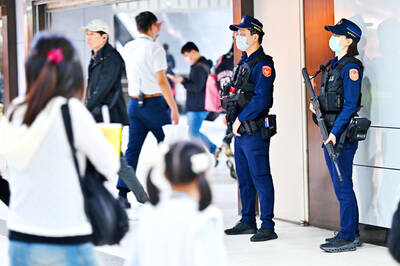Representatives of the self-help organization of Siaolin Village (小林), Kaohsiung County, that was wiped out by Typhoon Morakot in August, leaving nearly 500 people buried by massive landslides, yesterday called for a debate with the government over the causes of the disaster.
The demand came after the release of an official report by the Public Construction Commission (PCC) on Monday that blamed the tragedy on record rainfall and not a water diversion project many typhoon survivors considered the main reason.
“We have substantial evidence to challenge the findings and do not fear a debate. The report was fraught with errors. If our request is denied, we will see them in court,” Lu Tai-ying (魯台營) told the Taipei Times by telephone.
Lu said that while the report claimed the main cause of the mudslide was the 1,856mm of rain that fell within 72 hours in Siaolin, the village was flattened 48 hours after the rain began.
“When the mudslide occurred, the accumulated rainfall was between 1,400mm and 1,500mm. If the report was right about the critical value of precipitation, which it said was 1,700mm, rainfall should be one of the causes, but not the main cause,” Lu said.
Lu also questioned the adequacy of the rationale used to rule out the possibility of the trans-basin water diversion tunnel project, designed to channel water from the Laonong River (荖濃溪) to the Zengwun Reservoir (曾文水庫), as the prime cause of the mudslide.
At a press conference held yesterday morning to present the report, Shannon Lee (李咸亨), spokesman of the team in charge of the report, likened the impact on the local geology caused by the tunnel’s drill and blast construction method to hits by a mosquito.
”I really wanted to find evidence that supports the claim [that the tunnel project was behind the mudslide], but I couldn’t,” Lee said.
Lee said the tremors caused by the construction of the tunnel did not exceed the threshold that would lead to the disaster.
He said the conclusion was partly drawn from the fact that the non-conformance rate of tremors caused by the construction work during the period between 2006 and 2008 was less than the normal environment background level recorded between 2004 and 2006, according to the data kept by the Environment Protection Administration.
The construction began on Dec. 20, 2006.
Lee said the report’s conclusion was also based on the fact that the amount of explosives used to blast the tunnel was insufficient to have caused tremors large enough to lead to disaster.
The largest amount of explosives used at any one time was 182kg, less than the tremor caused by the 2006 Hengchun Earthquake, the equivalent of 475 million kilograms of explosives.
“I was also challenged by people who said that even small tremors could cause disasters when they are repeated,” Lee said.
“My answer was: ‘The tremor caused by the drill-and-blast method was like the energy released by a firework. Even if a firework is ignited 100 times, the energy still cannot be compared to the energy that is released by an earthquake,’” Lee said.
“If a person is hit by a mosquito several hundred times, it can’t be compared to being run over by a tank,” he said.
Lu, however, said that the report did not give direct evidence to prove that the impact of the water diversion project was negligible.
“What basis do they have to claim that the project was unrelated? The [stated-owned] Central Geological Survey recently found that the tunnel was constructed across a fault called the Nei-ying Fault [內英斷層]. The report didn’t even mention that,” Lu said.
Given the fact that the country had never completed a thorough survey into its geology and had a very limited understanding, “why did they jump to such a conclusion?” Lu said.
Later yesterday, Lee said by telephone that while he agreed with Lu about the “lack of a detailed understanding of the sensitivity of geology,” the conclusions reached by his team remained valid.
“In theory, it is possible that a tunnel construction project could cause a mudslide ... but in this case, it was an extremely low likelihood,” Lee said.
Lee said he regretted that a plan, suggested by Wulf Schubert, an Austrian expert, to use the drill-and-blast method to construct an experimental tunnel at 16 sites to test the impact of such a project on the environment was called off due to opposition by residents.
PCC chairman Frank Fan (范良銹) said the commission would refer the report to the Executive Yuan, which will decide whether to resume the suspended water diversion project.
The research team was formed by members of the Chinese Institute of Civil and Hydraulic Engineering (CICHE) and led by Chen Ching-chun (陳清泉), a professor at the Department of Civil Engineering at National Taiwan University.

TRAGEDY STRIKES TAIPEI: The suspect died after falling off a building after he threw smoke grenades into Taipei Main Station and went on a killing spree in Zhongshan A 27-year-old suspect allegedly threw smoke grenades in Taipei Main Station and then proceeded to Zhongshan MRT Station in a random killing spree that resulted in the death of the suspect and two other civilians, and seven injured, including one in critical condition, as of press time last night. The suspect, identified as a man surnamed Chang Wen (張文), allegedly began the attack at Taipei Main Station, the Taipei Fire Department said, adding that it received a report at 5:24pm that smoke grenades had been thrown in the station. One man in his 50s was rushed to hospital after a cardiac arrest

SAFETY FIRST: Double the number of police were deployed at the Taipei Marathon, while other cities released plans to bolster public event safety Authorities across Taiwan have stepped up security measures ahead of Christmas and New Year events, following a knife and smoke bomb attack in Taipei on Friday that left four people dead and 11 injured. In a bid to prevent potential copycat incidents, police deployments have been expanded for large gatherings, transport hubs, and other crowded public spaces, according to official statements from police and city authorities. Taipei Mayor Chiang Wan-an (蔣萬安) said the city has “comprehensively raised security readiness” in crowded areas, increased police deployments with armed officers, and intensified patrols during weekends and nighttime hours. For large-scale events, security checkpoints and explosives

A car bomb killed a senior Russian general in southern Moscow yesterday morning, the latest high-profile army figure to be blown up in a blast that came just hours after Russian and Ukrainian delegates held separate talks in Miami on a plan to end the war. Kyiv has not commented on the incident, but Russian investigators said they were probing whether the blast was “linked” to “Ukrainian special forces.” The attack was similar to other assassinations of generals and pro-war figures that have either been claimed, or are widely believed to have been orchestrated, by Ukraine. Russian Lieutenant General Fanil Sarvarov, 56, head

PUBLIC SAFETY: The premier said that security would be tightened in transport hubs, while President Lai commended the public for their bravery The government is to deploy more police, including rapid response units, in crowded public areas to ensure a swift response to any threats, President William Lai (賴清德) said yesterday after a knife attack killed three people and injured 11 in Taipei the previous day. Lai made the remarks following a briefing by the National Police Agency on the progress of the investigation, saying that the attack underscored the importance of cooperation in public security between the central and local governments. The attack unfolded in the early evening on Friday around Taipei Main Station’s M7 exit and later near the Taipei MRT’s Zhongshan